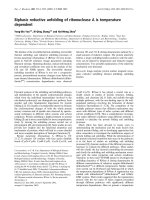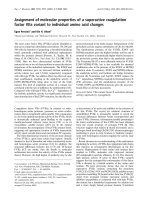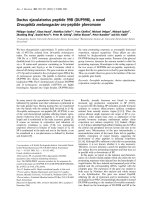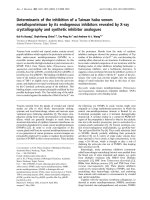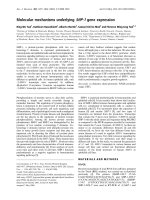Báo cáo y học: "Septic-associated encephalopathy - everything starts at a microlevel" potx
Bạn đang xem bản rút gọn của tài liệu. Xem và tải ngay bản đầy đủ của tài liệu tại đây (154.79 KB, 2 trang )
COM M E N T AR Y Open Access
Septic-associated encephalopathy - everything
starts at a microlevel
Tarek Sharshar
1*
, Andrea Polito
1
, Anthony Checinski
1
, Robert D Stevens
2
See related research by Taccone et al., />Abstract
Sepsis-associated encephalopathy is associated with increased mortality and morbidity. Its pathophysiology remains
insufficiently elucidated, although there is evidence for a neuroinflammatory process sequentially involving
endothelial activation, blood-brain barrier alteration and cellular dysfunction and alteration in neurotransmission.
Experimental studies have shown that microcirculatory dysfunction, a consequence of endothelial activation, is an
early pathogenic step. To date, we do not know whether it is present in septic patients, whether it accounts for
clinical features and whether it is treatable.
The experimental study by Taccone and colleagues
recently published in Critical Care [1] aims to deter-
mine whether sepsis is associated with early cerebral
micro-circulatory failure, which is believed to play a role
in the pathophysiology of sepsis-associated encephalopa-
thy (SAE). SAE i s a frequent and severe complication of
sepsis as it is associated with increased mortality, mor-
bidity and plausibly with diminished long-term cognitive
performance [2,3]. Evidence suggests that SAE results
from an alteration of neurotransmission, the mechan-
isms of which are insufficiently elucidated.
One pathophysiologic scenario is an inflammatory
process that starts by cerebral endothelial activation [3],
which directly releases or, through alteration of the
blood-brain barrier, facilitates the passage of inflamma-
tory mediators (that is, cytokines, chemokines) into the
parenchyma. Increased permeability of the blood-brain
barrier has been extensively documented in experimen-
tal models of sepsis, has been linked to complement
activation [4], and has been observed in septic patients
using magnetic resonance imaging (MRI) [5]. In turn,
these inflammatory mediators will affect all brain cells.
Van Gool and colleagues [6] proposed that sepsis-
induced microglial activation plays a role in delirium.
Inflammatory mediators are able to alter cellular meta-
bolism by inducing oxidative stress and mitochondrial
dysfunction [7], resulting in pathologic abnormalities
that range from alterations of neurotransmission to
apoptosis [8]. It has been shown that experimental sep-
sis, via inflammatory mediators, alters brain cholinergic
[9], beta-adrenergic, gamma-aminobutyric acid and sero-
toninergic signalling, predominately in the neocortex
and hippocampus [10]. This feature may account for the
electroencephalographic disturbances reported in septic
patients [11]. Additional factors that compound this
neuroinflammatory process include the release of excita-
tory amino acids, hyperglycemia, exposure to neurotoxic
pharmacologic agents, hemodynamic alterations, coagu-
lopathy, and hypoxemia [3].
One major consequence of endothelial activation is
that it may compromise regional brain tissue perfusion
by altering microcirculation. Microcirculator y dysfunc-
tion (MD) has previously been experimentally assessed,
notably by measuring neurovascular coupling. This con-
sists of assessing changes in cortical flow velocity during
somatosensory activation [12]. Interestingly, this MD
preceded both neurophysiologic and macrocirculatory
alterations, indicatin g that it is an early ste p in the
pathogenesis of SAE. Taccone and colleagues [1] pro-
vide a convincing visual demonstration of this phenom-
enon. Using cortical videomicroscopy in an ovine
peritonitis model, they found evidence of a reduced den-
sity of perfused and functional capillaries. But if the
* Correspondence:
1
Department of Intensive Care Medicine, Raymond Poincaré teaching
Hospital and University of Versailles Saint-Quentin en Yvelines, 104 Boulevar d
Raymond Poincaré, 92380 Garches, France
Full list of author information is available at the end of the article
Sharshar et al. Critical Care 2010, 14:199
/>© 2010 BioMed Central Ltd
occurrence of MD during experimental sepsis is estab-
lished, it remains to be seen whether this phenomenon
is present in septic patients, whether it accounts for
clinical features of SAE and whether it is treatable. The
microcirculation has not been evaluate d in septic
patients; in contrast, se veral studies have examined
macrocirculatory changes with inconsistent results [3].
One argument may be the impairment of autoregulation
reported in some studies of septic patients [13],
although autoregulation is pr imarily determined by
arterioles, which lie outside micro-circulation. Neuro-
pathologic findings of diffuse ischemic damages and
micro-haemorrhages support this hypothesis [ 14].
Recent advances in MRI are enabling important infer-
ences regarding the cerebral microcirculation; however,
simpler techniques are needed to directly assess and
monitor cerebral microcirculation or correlated markers
at the bedside. It would be of interest to determine
whether cerebral MD is correlated with micro-circul a-
tory disturbances in other organs that are more easily
amenable to direct assessment. The neurological conse-
quence of MD is unk nown, although one study interest-
ingly showed that delirium in septic patients is
associated with disturbed autoregulation rather than
with altered cerebral blood flow or tissue oxygenation
[13].
The clinical importance of cerebral microcirculatory
impairment in sepsis might be confirmed by assessing
the effects of therapeutic interventio n. Prominent
micro-circulatory effects of various agents have been
tested in septic animals, including curcumin, bradykinin,
inducible nitric oxide synthase (iNOS) inhibitors, anti-
cytokines or complement antibodies and glucocorticoids
[15]. The effects of glucocorticoids and that of other
therapeutic agents used in sepsis (that is, activated pro-
tein C) on SAE are unknown. One other major unan-
swered issue is whether targeting higher systemic blood
pressures will improve cerebral perfusion and oxygena-
tion in the presence of MD.
OnemayarguethatMDismerelyonefeatureinthe
complex pathogenesis of SAE. In the experimental set-
ting it will be important to develop agents or strategies
that modulate what ostensibly is an early pathogenic
phenomenon rather than targeting later events that may
not be r eversi ble. In patients, we need more evidence of
the role of microcirculation in SAE. This will require
techniques to measure and monitor the cerebral micro-
circulation at the bedside.
Abbreviations
MS: microcirculatory dysfunction; MRI: magnetic resonance imaging; SAE:
sepsis-associated encephalopathy.
Author details
1
Department of Intensive Care Medicine, Raymond Poincaré teaching
Hospital and University of Versailles Saint-Quentin en Yvelines, 104 Boulevar d
Raymond Poincaré, 92380 Garches, France.
2
Department of Anesthesiology
Critical Care Medicine, Johns Hopkins University School of Medicine, Meyer
8-140, 600 N Wolfe St, Baltimore, MD 21287, USA.
Competing interests
The authors declare that they have no competing interests.
Published: 29 September 2010
References
1. Taccone FS, Su F, Pierrakos C, He X, James S, Dewitte O, Vincent JL, De
Backer D: Cerebral microcirculation is impaired during sepsis: an
experimental study. Crit Care 2010, 14:R140.
2. Eidelman LA, Putterman D, Putterman C, Sprung CL: The spectrum of
septic encephalopathy. Definitions, etiologies, and mortalities. JAMA
1996, 275:470-473.
3. Iacobone E, Bailly-Salin J, Polito A, Friedman D, Stevens RD, Sharshar T:
Sepsis-associated encephalopathy and its differential diagnosis. Crit Care
Med 2009, 37:S331-S336.
4. Flierl M, Stahel P, Rittirsch D, Huber-Lang M, Niederbichler AD, Hoesel LM,
Touban BM, Morgan SJ, Smith WR, Ward PA, Ipaktchi K: Inhibition of
complement C5a prevents breakdown of the blood-brain barrier and
pituitary dysfunction in experimental sepsis. Crit Care 2009, 13:R12.
5. Sharshar T, Carlier R, Bernard F, Guidoux C, Brouland JP, Nardi O, de la
Grandmaison GL, Aboab J, Gray F, Menon D, Annane D: Brain lesions in
septic shock: a magnetic resonance imaging study. Intensive Care Med
2007, 33:798-806.
6. van Gool WA, van de Beek D, Eikelenboom P: Systemic infection and
delirium: when cytokines and acetylcholine collide. Lancet 2010,
375:773-775.
7. Messaris E, Memos N, Chatzigianni E, Konstadoulakis MM, Menenakos E,
Katsaragakis S, Voumvourakis C, Androulakis G: Time-dependent
mitochondrial-mediated programmed neuronal cell death survival in
sepsis. Crit Care Med 2004, 32:1764-1770.
8. Sharshar T, Gray F, Lorin de la Grandmaison GL, Hopkinson NS, Ross E,
Dorandeu A, Orlikowski D, Raphael JC, Gajdos P, Annane D: Apoptosis of
neurons in cardiovascular autonomic centres triggered by inducible
nitric oxide synthase after death from septic shock. Lancet 2003,
362:1799-1805.
9. Semmler A, Frisch C, Debeir T, Ramanathan M, Okulla T, Klockgether T,
Heneka MT: Long-term cognitive impairment, neuronal loss and reduced
cortical cholinergic innervation after recovery from sepsis in a rodent
model. Exp Neurol 2007, 204:733-740.
10. Hellstrom IC, Danik M, Luheshi GN, Williams S: Chronic LPS exposure
produces changes in intrinsic membrane properties and a sustained IL-
β-dependent increase in GABAergic inhibition in hippocampal CA1
pyramidal neurons. Hippocampus 2005, 15:656-664.
11. Oddo M, Carrera E, Claassen J, Mayer SA, Hirsch LJ: Continuous
electroencephalography in the medical intensive care unit. Crit Care Med
2009, 37:2051-2056.
12. Rosengarten B, Wolff S, Klatt S, Schermuly RT: Effects of inducible nitric
oxide synthase inhibition or norepinephrine on the neurovascular
coupling in an endotoxic rat shock model. Crit Care 2009, 13:R139.
13. Pfister D, Siegemund M, Dell-Kuster S, Smielewski P, Rüegg S, Strebel SP,
Marsch SC, Pargger H, Steiner LA: Cerebral perfusion in sepsis-associated
delirium. Crit Care 2008,
12:R63.
14. Sharshar T, Annane D, de la Gradmaison GL, Brouland JP, Hopkinson NS,
Françoise G: The Neuropathology of Septic Shock. Brain Pathol 2004,
14:21-33.
15. Vachharajani V, Vital S, Russell J, Scott LK, Granger DN: Glucocorticoids
Inhibit the Cerebral Microvascular Dysfunction Associated with Sepsis in
Obese Mice. Microcirculation 2006, 13:477-487.
doi:10.1186/cc9254
Cite this article as: Sharshar et al.: Septic-associated encephalopathy -
everything starts at a microlevel. Critical Care 2010 14:199.
Sharshar et al. Critical Care 2010, 14:199
/>Page 2 of 2


